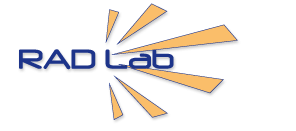Accessibility
This is the official accessibility statement for the UC Berkeley RAD Lab Web site. We are committed to ensuring that this Web site is accessible to everyone. If you have any questions or suggestions regarding the accessibility of this site, please radlab-admin [at] eecs [dot] berkeley [dot] edu (contact us), as we are continually striving to improve the experience for all visitors.
Standards compliance
- All pages on this site follow U.S. Federal Government Section 508 Guidelines.
- All pages on this site follow priorities 1 & 2 guidelines of the W3C Web Content Accessibility Guidelines.
- All pages on this site validate as HTML 4.01 Strict.
- All pages on this site use structured semantic markup.
H1elements are used for main titles,H2,H3, &H4elements for subtitles. For example, on this page, JAWS users can skip to the next section within the accessibility statement by pressing ALT+INSERT+3. Opera users can skip sections by using "S" and "W" to cycle forwards and backwards respectively through headings.
Structural Markup
Web pages on the UC Berkeley RAD Lab Web site include 4 different areas:
- The Banner,
- The primary navigation
- The additional information area,
- The footer.
When CSS (Cascading Styles Sheet) are not applied to a document (or when using a screen reader), the 4 areas are read in the above order.
Access Keys
This site does not use the accesskey attribute. Most browsers support jumping to specific links by typing keys defined on the web site. Unfortunately, access keys often clash with keys set aside for use with other UAs (i.e. assistive technology). For this reason, we have decided to not set default access keys.
Images
- Unless they are purely decorative items, all images used on this web site have suitable
altattributes. - Content ought to be usable/accessible with images "off" (disabled).
Links
- Many links have title attributes which describe the link in greater detail, unless the text of the link already fully describes the target.
- Links are written to make sense out of context.
- URLs are permanent whenever possible.
Scripts
- We are using non obtrusive client-side scripts.
- Content of this web site is usable without JavaScript support.
Pop up Windows
- In visual browsers, unless Javascript is disabled, a small icon appears next to links to external resources.
- Browsers with Popup Blockers ought to be able to access these external documents.
Visual design
- This site uses cascading style sheets for visual layout.
- This site uses only relative font sizes, compatible with the user-specified "text size" option in visual browsers.
- If your browser or browsing device does not support stylesheets at all, the content of each page is still readable.
- Any information conveyed through the use of color is also available without color (i.e. text based).
How to modify this site to fit your needs
These links explain the many ways you can make the web more accessible to you.
Accessibility references
- W3 accessibility guidelines, which explains the reasons behind each guideline.
- W3 accessibility techniques, which explains how to implement each guideline.
- W3 accessibility checklist, a busy developer's guide to accessibility.
- U.S. Federal Government Section 508 accessibility guidelines.
Accessibility software
- JAWS, a screen reader for Windows. A time-limited, downloadable demo is available.
- Home Page Reader, a screen reader for Windows. A downloadable demo is available.
- Lynx, a free text-only web browser for blind users with refreshable Braille displays.
- Links, a free text-only web browser for visual users with low bandwidth.
- Opera, a visual browser with many accessibility-related features, including text zooming, user stylesheets, image toggle. A free downloadable version is available. Compatible with Windows, Macintosh, Linux, and several other operating systems.
Accessibility services
- Bobby, a free service to analyze web pages for compliance to accessibility guidelines. A full-featured commercial version is also available.
- HTML Validator, a free service for checking that web pages conform to published HTML standards.
- Web Page Backward Compatibility Viewer, a tool for viewing your web pages without a variety of modern browser features.
- Lynx Viewer, a free service for viewing what your web pages would look like in Lynx.
Related resources
- WebAIM, a non-profit organization dedicated to improving accessibility to online learning materials.
- Designing More Usable Web Sites, a large list of additional resources.
